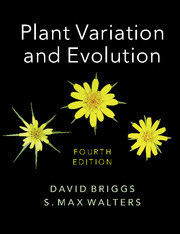Book contents
- Frontmatter
- Contents
- Preface to the Fourth Edition
- Acknowledgements
- Note on names of plants
- List of abbreviations
- 1 Investigating plant variation and evolution
- 2 From Ray to Darwin
- 3 Early work on biometry
- 4 Early work on the basis of individual variation
- 5 Post-Darwinian ideas about evolution
- 6 DNA: towards an understanding of heredity and molecular evolution
- 7 Breeding systems
- 8 Intraspecific variation and the ecotype concept
- 9 Pattern and process in plant populations
- 10 Pattern and process: factors interacting with natural selection
- 11 Populations: origins and extinctions
- 12 Species and speciation: concepts and models
- 13 Allopatric speciation and hybridisation
- 14 Abrupt speciation
- 15 The species concept
- 16 Flowering plant evolution: advances, challenges and prospects
- 17 Historical biogeography
- 18 The evolutionary impact of human activities
- 19 The taxonomic challenge ahead
- 20 Conservation: from protection to restoration and beyond
- Glossary
- References
- Index
8 - Intraspecific variation and the ecotype concept
Published online by Cambridge University Press: 05 June 2016
- Frontmatter
- Contents
- Preface to the Fourth Edition
- Acknowledgements
- Note on names of plants
- List of abbreviations
- 1 Investigating plant variation and evolution
- 2 From Ray to Darwin
- 3 Early work on biometry
- 4 Early work on the basis of individual variation
- 5 Post-Darwinian ideas about evolution
- 6 DNA: towards an understanding of heredity and molecular evolution
- 7 Breeding systems
- 8 Intraspecific variation and the ecotype concept
- 9 Pattern and process in plant populations
- 10 Pattern and process: factors interacting with natural selection
- 11 Populations: origins and extinctions
- 12 Species and speciation: concepts and models
- 13 Allopatric speciation and hybridisation
- 14 Abrupt speciation
- 15 The species concept
- 16 Flowering plant evolution: advances, challenges and prospects
- 17 Historical biogeography
- 18 The evolutionary impact of human activities
- 19 The taxonomic challenge ahead
- 20 Conservation: from protection to restoration and beyond
- Glossary
- References
- Index
Summary
We saw in Chapter 7 how different breeding systems can be expected to produce different patterns of variation. If we are to understand the variation patterns actually found in nature and the processes that give rise to these patterns, we must discover how the potential variation in seeds relates to the variation of reproductively mature plants. Historically, the first advances in this field were made by means of comparisons between plants belonging to the same species but from different populations. Taxonomists, biometricians and, later, geneticists became interested in genetic variation in the wild, and many of their studies converged at one point, namely, the controversy over the ‘reality’ of the intraspecific groups, which could be distinguished in nature, and whether they were the subspecies or varieties of the taxonomist or the ‘local races’ of the biometrician. A new look at this old question was provided by the famous researches of Turesson published in the early 1920s.
Turesson's pioneer studies and other experiments
At the time of Turesson's experiments, the question of the reality of ‘local races’ was combined with another controversial issue, namely how much of the observed variation in natural populations was the result of the direct modification of plants subjected to severe environmental stresses. By the end of the nineteenth century, many botanists reasoned that distinctive intraspecific variants were merely ‘habitat modifications’. Turesson, however, pointed out that in all previous cases known to him, only a partial test of the ‘habitat modification’ hypothesis had been carried out. For example, he considered the studies of Lathyrus japonicus (L. maritimus) undertaken by Schmidt (1899). Baltic populations of this plant have dorsiventral leaves, whilst on the North Sea coast of Denmark the plant has isolateral leaves. Schmidt showed, by experiment, that watering the Baltic variant with sodium chloride solutions induced a leaf structure typical of Danish plants. Given that the North Sea has a higher percentage content of salt than Baltic waters, Schmidt deduced that the leaf structure of the plants on the North Sea coast of Denmark was merely a habitat modification.
The logic of this type of deduction did not satisfy Turesson. His approach to the problem was to grow samples of several variants of a species in a standard garden, to see if ‘distinctiveness’ was retained or lost.
- Type
- Chapter
- Information
- Plant Variation and Evolution , pp. 135 - 159Publisher: Cambridge University PressPrint publication year: 2016



